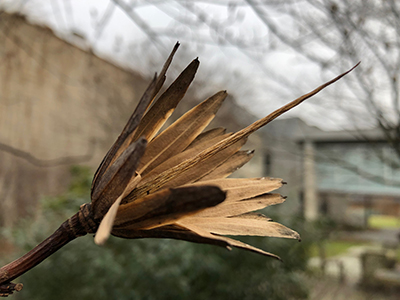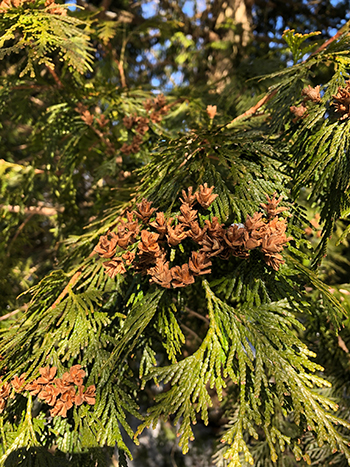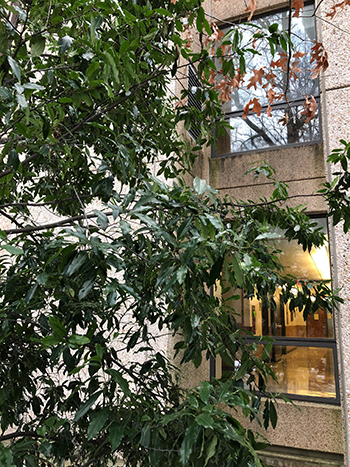
Plants of the Week: January 14
 Liriodendron tulipifera is one of the tallest hardwoods in eastern North America, with a straight trunk capable of reaching 200’ in height. The height, as well as its tendency to only branch toward the canopy help create a column-like appearance, a habit utilized to great effect in the Scott Outdoor Amphitheater where the trees act as living columns within the Thomas W. Sears design.
Liriodendron tulipifera is one of the tallest hardwoods in eastern North America, with a straight trunk capable of reaching 200’ in height. The height, as well as its tendency to only branch toward the canopy help create a column-like appearance, a habit utilized to great effect in the Scott Outdoor Amphitheater where the trees act as living columns within the Thomas W. Sears design.
Liriodendron, also known as tuliptree, produces beautiful tulip-like yellow-orange flowers. Borne high in the tree, they are often missed. The oblong, cone-shaped fruits bear numerous winged seeds. Persisting throughout the winter, the fruits add interest and make a great addition to floral arrangements. Several trees within eyes-reach can be closely inspected at the back of the Pollinators Garden. Photo credit: J. Coceano

Thuja plicata, the western arborvitae, is one of two Thuja species native to North America. The species name plicata derives from the Latin word plicāre and means “folded in plaits” or “braided,” a reference to the pattern of its small leaves. The foliage forms flat sprays with scale-like leaves in opposite pairs. Green to yellow-green cones mature brown and open at maturity to shed seeds.
‘Atrovirens’ is a fast-growing, strongly pyramidal cultivar with reddish-brown bark and aromatic foliage. An elegant conifer in form and habit, Thuja plicata has been described as “elegantly postured” with branches and foliage “like a lady’s hand outstretched for a kiss.” Highly adaptable, the species is hardy from zones 5 to 7. A specimen can be found in the Pinetum. Photo credit: J. Coceano

Prunus caroliniana, commonly called cherrylaurel, is an evergreen tree or large shrub native to the thickets and low woods of southeastern North Carolina to Florida west to Arkansas, Louisiana and Texas. Glossy, dark green 2-4” leaves are lanceolate-oblong in shape with a pointed tip. White flowers are followed by green fruits that turn reddish-purple, then black at full maturity. Birds relish the fruit and aid in its tendency to self-seed.
Rarely seen this far north, a specimen inhabits a protected recess against the Science Center near the Water Tower. Further south it is commonly used as a screening plant and in plantings for wildlife where it provides shelter and food. Prunus caroliniana is a host plant for several species of butterflies including the Eastern Tiger Swallowtail and Coral Hairstreak. Photo credit: J. Coceano





No Comments